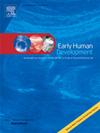抬高侧卧喂养和节奏奶瓶喂养对健康早产儿吞咽呼吸协调的影响——初步结果。
IF 2
3区 医学
Q2 OBSTETRICS & GYNECOLOGY
引用次数: 0
摘要
背景:早产儿在吸吮-吞咽-呼吸协调方面面临挑战,导致误吸风险增加。吞咽过程的关键组成部分出现在月经后34至35周(PMA),但早产儿过早疲劳会影响吞咽的时间、质量和效率,并延长呼吸暂停。进食策略需要解决这些在吮吸-吞咽-呼吸协调方面的具体挑战。目的:客观评价体位及“节奏奶瓶喂养”对早产儿吞咽及呼吸功能的影响。方法:采用生物阻抗、体表肌电图和呼吸带相结合的无创测量装置,对34 ~ 35周龄单瓶喂养的早产儿进行测量,每组20例。在第一项研究(S1)中,将侧卧抬高喂养与仰卧抬高喂养各2分钟进行比较。在第二项研究(S2)中,将2分钟有节奏的奶瓶喂养与2分钟没有节奏的奶瓶喂养进行比较。结果:(S1):与仰卧姿势相比,侧卧姿势进食导致窒息和咳嗽发作明显减少,呼吸暂停明显缩短,吞咽动作变化明显减少。在饲喂开始时,仰卧的咽部闭合明显更大。(S2):有节奏奶瓶喂养的应用显著减少了呼吸暂停的时间。结论:34 ~ 35周PMA健康早产儿采用侧卧抬高体位喂养和有节奏的奶瓶喂养有助于改善吞咽呼吸协调。本文章由计算机程序翻译,如有差异,请以英文原文为准。
Effect of feeding in elevated side-lying and paced bottle feeding on swallow-breathe coordination in healthy preterm infants – First results
Background
Preterm infants face challenges in their suck-swallow-breathe coordination leading to an increased risk of aspiration. Key components of the swallowing process are present around 34 to 35 weeks postmenstrual age (PMA), but preterm infants fatigue early affecting timing, quality and efficiency in swallowing and prolonging breathing pauses. Feeding strategies need to address these specific challenges in suck-swallow-breathe coordination.
Aim
To objectively measure the effect of positioning and applying “paced bottle feeding” on swallowing and breathing function in preterm infants.
Methods
Two separate groups of each 20 preterm infants were measured during a single bottle feed at the age of 34 to 35 weeks PMA using a noninvasive measuring device combining bioimpedance, surface electromyography as well as a breathing belt. In the first study (S1) feeding in elevated side-lying was compared to elevated supine position for 2 min each. In the second study (S2) 2 min of paced bottle feeding was compared to 2 min without paced bottle feeding.
Results
(S1): Feeding in elevated side-lying led to significantly fewer episodes of choking and coughing, significantly shorter breathing pauses and significantly less variation in swallowing movements than in elevated supine. Pharyngeal closure was significantly greater in supine at the start of the feed. (S2): The application of paced bottle feeding significantly reduced the length of breathing pauses.
Conclusions
Feeding in elevated side-lying position and applying paced bottle feeding may support improved swallow-breathe coordination in healthy preterm infants at 34 to 35 weeks PMA.
求助全文
通过发布文献求助,成功后即可免费获取论文全文。
去求助
来源期刊

Early human development
医学-妇产科学
CiteScore
4.40
自引率
4.00%
发文量
100
审稿时长
46 days
期刊介绍:
Established as an authoritative, highly cited voice on early human development, Early Human Development provides a unique opportunity for researchers and clinicians to bridge the communication gap between disciplines. Creating a forum for the productive exchange of ideas concerning early human growth and development, the journal publishes original research and clinical papers with particular emphasis on the continuum between fetal life and the perinatal period; aspects of postnatal growth influenced by early events; and the safeguarding of the quality of human survival.
The first comprehensive and interdisciplinary journal in this area of growing importance, Early Human Development offers pertinent contributions to the following subject areas:
Fetology; perinatology; pediatrics; growth and development; obstetrics; reproduction and fertility; epidemiology; behavioural sciences; nutrition and metabolism; teratology; neurology; brain biology; developmental psychology and screening.
 求助内容:
求助内容: 应助结果提醒方式:
应助结果提醒方式:


